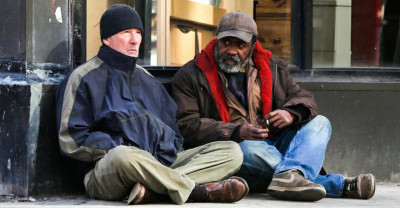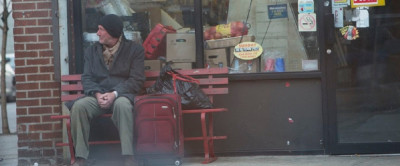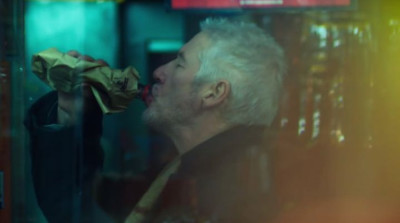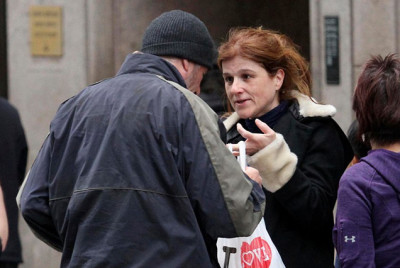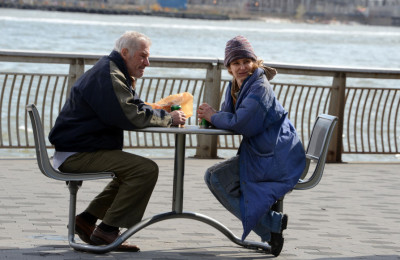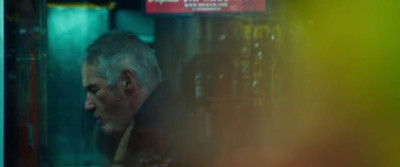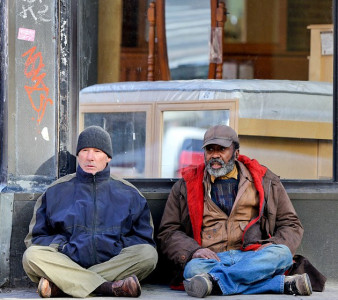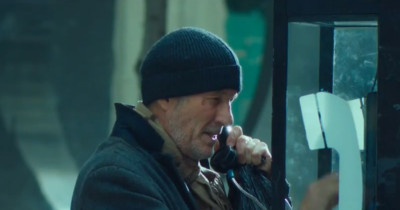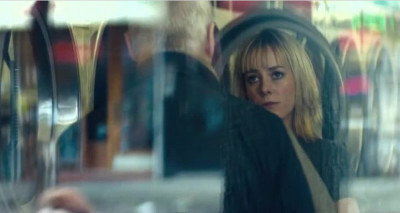The Oscar race just got real with the release of Oren Moverman’s TIME OUT OF MIND. Led by a tour de force performance by Richard Gere that is arguably the finest of his career, and one which should potentially garner him a Best Actor nomination, and unparalleled cinematography by Bobby Bukowski, TIME OUT OF MIND should be assured not only recognition comes awards time, but secure a place in the annals of cinematic excellence. If ever a film could be described as having “a soul”, this would be the one. TIME OUT OF MIND is masterful.
George Hammond is lost; lost to society and lost to himself. Barely functioning, he is one of the thousands of homeless on the streets of New York who recede into the concrete jungle, hiding from the world and from themselves. At first glance, it appears that George was once a respected member of society. Although worn, his coat and his shoes belie what is now a state of homeless poverty. Fleeting moments of lucidity in arguing with a stranger for the right to stay in a now abandoned apartment give indications of a higher education, but the synapses appear to be no longer be firing on all cylinders. George is alone. Whatever life he once had is gone. Even his wallet, any trace of identification are gone. He is, for all intents and purposes, invisible to society, to us, and as we eventually learn, invisible to his estranged daughter Maggie.
George is part of the marginalized fringes to which society turns a blind eye and in which life revolves not around planning outfits for work or school, or making dinner reservations or deciding what movie to see, but rather, in moments of survival – where can he get a bed at night or shelter in inclement weather or a meager meal. But sometimes all it takes is one moment to create a spark of hope or life; one bit of connection with another human being that might help George find his way back.
For George, that spark comes from Dixon. An older experienced shelter-dweller, Dixon knows the ins and outs of the system and how to get a bed at night. Once the most famous insane asylum in New York, Bellevue Hospital has been repurposed and is now the largest homeless intake center and men’s housing shelter in Manhattan. Dixon sleeps there almost every night. But there’s a process. You need identification, you have to stand in lines, you have to abide by the rules, but you get a bed and a roof over your head. And once you get “into the system”, you can get help with food and maybe even find your way back to the world you left behind. Although George is at first trepidatious at this offer of navigational help and this hand of friendship extended by Dixon, he soon takes that hand and the world starts to take on some color, some light, some life, some hope; hope that he might one day no longer be alone, but have his daughter back in his life. And as George slowly finds his way back to society, those around him – and us in the audience – begin to see him again. He is no longer invisible.
TIME OUT OF MIND is a visual masterpiece. The essence and style boil down to Richard Gere’s introverted performance and Bobby Bukowski’s lighting and lensing. Although there is minimal dialogue, so powerful is the one-two punch of Gere and Bukowski under Moverman’s keen direction, that dialogue isn’t even necessary. The city and its sounds are our dialogue. There is an almost cyclic randomness to this world and to George’s very existence that fuels the film as a whole. Methodical in their cinematic construction, Moverman and Bukowski are meticulous and specific in their visual storytelling, creating a poetry with its dichotomous beauty and seeming simplicity. Visuals are alive and allow the city to live and breathe around the character of George, as if metaphorically suffocating him with the world as he gasps for air.
As the film opens and we meet a lost, hidden and invisible George, lensing is done through layers of windows, via reflections or reflections in mirrors, under and through scaffolding, doorways, arches, really isolating George from the world so that it is visually and emotionally palpable. He is a blur at best. An observational film, according to Moverman, “We wanted to create the perspective for the movie [as] the perspective of the city, the perspective of people living in the city rushing around living their lives. A man like this, you have to make an effort to see him, to really see him, to really pay attention to what’s going on with him. So, we gave the perspective of the city which means you’ll see him through windows, you’ll see him through door frames, you’ll see him through rooftops, you’ll see him through shop windows, you’ll see him with bicycles going by. All these things that are getting in the way with you engaging with this person, for whatever reason, but also kind of holding you back from engaging on a compassionate level. It’s hard to feel compassion for people you don’t really know anything about or engage with their stories. As we get deeper and deeper into the story, as you say, these obstructions start melting away to the point that by the end of it, the movie is really quiet; there’s nothing in between him and the other characters he’s interfacing with.”
Using Hawk V-Plus anamorphic lenses, 300-900mm, the camera eavesdrops on George and the city swirling around him. Essentially carving out a horizontal canvas against the vertical upreach of the city itself, anamorphics suited the visual storytelling well in addition to providing a softer edge to the framing. With the 900mm, Bukowski and Moverman were allowed to remain completely removed from the actors to the point of being so distanced, no one even knows filming is occurring. There is never a cinematic intrusion so that the authenticity of not only Gere’s performance but the world bustling around him are pure, genuine, something which only serves to showcase Gere’s talent. A completely introverted and introspective performance, Gere is forced to play “from the inside”. There’s no camera for him to play to. He is forced to be alive and present in the moment, forcing an internal performance. Oren Moverman is still in awe of what Gere brought to the table. “To find external ways of showing [that] is so difficult and so challenging and he was able to do it every time which was really amazing to watch just from a spectator’s perspective for me.”
As the film progresses and George begins to interact more with people, with humanity, those early visual layers are stripped away in tandem with the emotional isolation. Color that is initially washed out, becomes brighter, more vibrant. Interesting is the use of the color red. Typically, one thinks of red as metaphorically referring to danger, anger or stop, but here, the color means something more as it tacitly provides a dual meaning for love and the father-daughter dynamic, particularly when the most vivid reds are always seen around the character of Maggie.
With visuals and emotion walking together, as there is emotional growth and reconnection, lensing becomes more personal, more connected. There are fewer scenes shot through glass or in doorways. Bukowski moves the camera in closer. Depth of field changes. And ultimately, we see quiet and stillness and the one scene in the film where the camera itself moves in a tracking shot. Neither the camera, the audience or George just observe. They live.
Sound design is an essential part of Moverman’s construct with TIME OUT OF MIND and is, in fact, its own character just as the city is a character. We are immersed, as is George, in the cacophony of the city obfuscating so much and adding to those layers of windows and mirrors and doorframes and bridges and construction. Then slowly the sound peels away along with the visuals as George finds himself. Sound was criucial to Moverman who succinctly notes, “the sound of the city and the sound of the city is quite insane if you listen to it. All of us are quite trained to block things out so we can actually maintain our sanity, but for a character like George who is not able to filter things out, who is not able to rush around and life his life but is actually just living moment to moment through his needs of warmth and shelter, a bed and food, all these basic needs, he can’t block those sounds out. So we threw everything in. As you know in NY, sound is one of the most overwhelming elements of existence here and a lack of any kind of quietness. Then just the overwhelming decibels that it gets to is a lot. We really wanted to push the envelope and get as far as we can with that sound to reflect the sound of the city but also reflect his mindset.” The result is flawless.
Quite compelling are scenes between Dixon and George which presumably occur within a homeless shelter. You may be surprised to learn, as I was, that that is actually the men’s shelter inside Bellevue. As Moverman relates, “We were allowed to film in Bellevue for an entire night which meant that we had to work very very fast. While over 800 men were sleeping around us, we shot those scenes of Richard [Gere] standing in line to get into the intake center. . .go through security, go through the intake process, get those questions and then kind of get his bed, and then be woken up early. We literally went through the entire process every human being who walks into that place would go through; with some alterations for time, basically.” Enabling a deeper realism and naturalism, it serves to strengthen the audience’s immersion into the idea of “walking a mile in George’s shoes.”
As George, Gere is virtually unrecognizable. Disheveled, confused and virtually invisible, his own transformation and immersion was so powerful, so believable, that on the streets of New York no one realized this dirty grizzled panhandler was even an actor, let alone Richard Gere. On screen, one forgets this is Richard Gere delivering a performance. The tacit strength of Gere’s sheer emotional power is overwhelming. Internalizing emotion, Gere constructs George withe physical nuance; a shuffle, a hunch, blinking eyes blinded by daylight, a look of bewilderment or despair. He is resonant. By disappearing, by becoming invisible, he makes us look even more intently, feel more intently. Gere mesmerizes with every step of George’s journey, eliciting emotions that range from disgust to pity to unwanted sympathy to empathy to hope. His performance is raw, visceral, unfiltered. He silently directs our attention to George and makes us want to look beyond those double and triple layers of windows, seeking clarity and understanding of the man and by extension, the disenfranchised as a whole.
Startling cameos are also found from Kyra Sedgwick, Steve Buscemi and Geraldine Hughes while Ben Vereen shines like a guardian angel as fellow homeless Dixon. Vereen is almost the equivalent of a guide, leading us through the inner workings of the homeless system in New York, all of which comes from Moverman and Gere meeting with not only the homeless themselves, but guards, administrators, people from the Coalition for the Homeless, former homeless turned activist, determined to shine a truthful light.
But then there’s Jena Malone. Described by Richard Gere as “strong and present in her character”, as George’s daughter Maggie, Malone is heartbreaking. You know there are daughters out there who have gone through something similar, are going through something similar. Malone nails it. And in the film’s climactic scene, fair warning. Have tissues in hand. Malone nails truth, emotion and love in fell swoop. As the light and the hope of TIME OUT OF MIND, Maggie also represents what the audience is experiencing. As Malone describes it, “She represents turning hat blind eye, the dissatisfaction, the anger, the ‘you need to do it for yourself’ point of view that a lot of people take with people who become homeless or choose more of the out of societal norm way of living their life. She’s very much where the audience is in the sense of judging him and telling him that he needs to take care of his own. . .It’s a very hard thing and I feel what this film does and what Maggie gave me is the bridge to be able to say, ‘Yes. I see your humanity. I don’t judge you and I’m not scared of it. I no longer see you as a black hole. I see you as a human being. And I see your humanity and I see your choices and I respect them.’”
TIME OUT OF MIND. A mirror of society. A mirror of ourselves. A masterful piece of filmmaking.
Written and Directed by Oren Moverman
Cast: Richard Gere, Ben Vereen, Jena Malone, Kyra Sedgwick, Steve Buscemi


